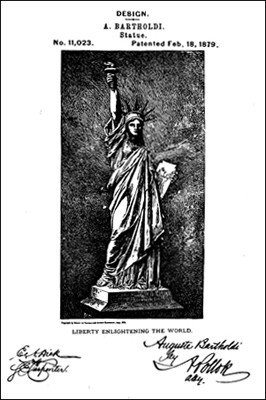 Did you know the subject of America’s most famous design patent wasn’t actually designed by an American?
Did you know the subject of America’s most famous design patent wasn’t actually designed by an American?
On February 18, 1879, French sculptor Auguste Bartholdi received US Patent D11,023 for a statue design – one he called, “Liberty Enlightening The World.”
You know her as The Statue of Liberty. She stands tall on her pedestal on Liberty Island, a beacon of hope for Freedom seekers the world over.
But, did you know the greatest symbol of American Opportunity almost didn’t happen due to a lack of funding? It’s true!
Auguste Bartholdi was commissioned in 1876 – the year of the American Centennial – to create the statue as a gift to America; it would be a symbol of friendship between France & the US for everyone to see. France would raise the money to build the sculpture, and America would handle the pedestal.
Simple, right?
Not really.
Even with Bartholdi’s patent – which he got specifically to allow him to create and sell replicas of Lady Liberty as a fundraising effort – France still had trouble finding enough public support. It took numerous auctions, art exhibits, lotteries and theater events were used to raise the needed funds from their end.
Construction of the statue began in 1875 and was not completed until nine years later in 1884. Alexandre Gustave Eiffel, the designer of the Eiffel tower, planned the skeletal framework for the statue. A larger-than-life representation of the Roman Goddess Libertas, Bartholdoi used two different women as models. The face is said to be a likeness of his mother. His wife posed for the arms and torso of Lady Liberty.
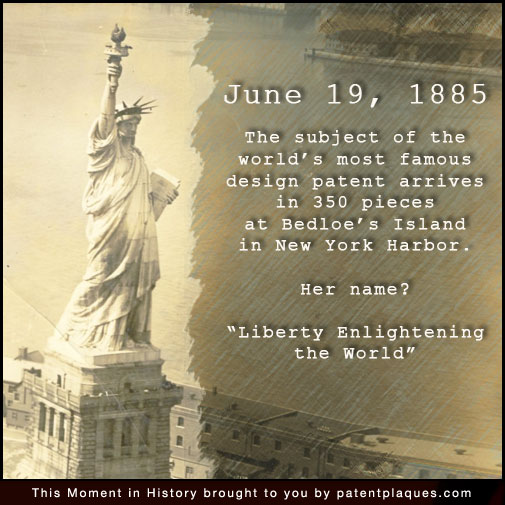
Liberty Enlightening the World
Meanwhile, America was having her own bit of funding problems. That is, until Joseph Pulitzer’s shame campaign against the wealthy and middle class alike spurred enough interest to finally fund the pedestal in 1885, just months before the statue – which had been shipped from France July of 1884 – arrived in New York.
So finally, on June 19, 1885, the world’s single, most powerful symbol of Freedom arrived in America in 350 pieces packed into 214 crates. They were reassembled in their place on Bedloe’s Island in New York Harbor. On October 28, 1886, before thousands of spectators, President Cleveland dedicated the Statue of Liberty on the now-named Liberty Island.
Lady Liberty stands 305 feet and 1 inch tall from its base to the tip of the torch and weighs 450,000 pounds. Each year over 3 million people visit the statue that has welcomed immigrants to Ellis Island since 1892.


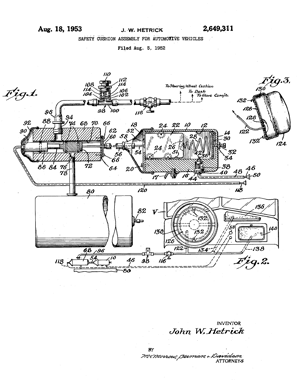 John Hetrick’s invention was the first prototype of today’s modern air bags and derived from an accident on a Sunday afternoon drive. In the spring of 1952, Hetrick, his wife and daughter went for a car ride in their 1948 Chrysler Windsor. The car veered into a ditch on the side of the road to avoid an on-road collision.
John Hetrick’s invention was the first prototype of today’s modern air bags and derived from an accident on a Sunday afternoon drive. In the spring of 1952, Hetrick, his wife and daughter went for a car ride in their 1948 Chrysler Windsor. The car veered into a ditch on the side of the road to avoid an on-road collision.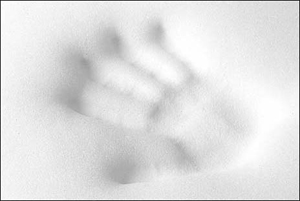 In 1966, scientists at NASA developed a open cell polyurethane-silicon plastic to improve the safety of seat cushions on spacecraft and to lessen the impact of landing. The soft cushion material wants to maintain it’s original form and structure when it is compressed. Even after being compressed to 10% of it sizes, the foam will return to its original shape and size which is why it is called memory foam.
In 1966, scientists at NASA developed a open cell polyurethane-silicon plastic to improve the safety of seat cushions on spacecraft and to lessen the impact of landing. The soft cushion material wants to maintain it’s original form and structure when it is compressed. Even after being compressed to 10% of it sizes, the foam will return to its original shape and size which is why it is called memory foam.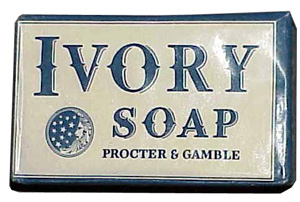 To better compete within the soap industry, Proctor & Gamble sought to create a high quality, affordable, duel bath bar and laundry product. In 1878, the first successful formula was created and produced under the name of White Soap.
To better compete within the soap industry, Proctor & Gamble sought to create a high quality, affordable, duel bath bar and laundry product. In 1878, the first successful formula was created and produced under the name of White Soap. The history of popcorn making and corn popping machines have seen much improvement. Advancements have allowed us to efficiently pop our favorite snack just in time for that movie. In the past, many methods had been executed to pop corn as a treat. One simple way was placing kernels over a fire on a hot rock. As the impact of the heat increased on the kernels, they would pop in different directions. People would chase after the pieces in order catch and enjoy the taste of this snack. Sadly, many of the corn kernels were charred. Luckily, there are easier ways to obtain this delightful goody and it began with the world’s first commercial popcorn machine.
The history of popcorn making and corn popping machines have seen much improvement. Advancements have allowed us to efficiently pop our favorite snack just in time for that movie. In the past, many methods had been executed to pop corn as a treat. One simple way was placing kernels over a fire on a hot rock. As the impact of the heat increased on the kernels, they would pop in different directions. People would chase after the pieces in order catch and enjoy the taste of this snack. Sadly, many of the corn kernels were charred. Luckily, there are easier ways to obtain this delightful goody and it began with the world’s first commercial popcorn machine.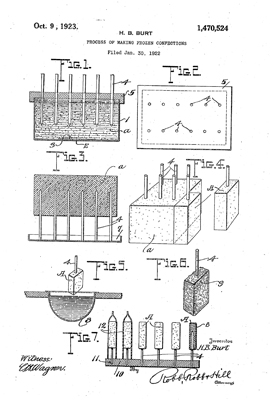 In 1920, a candy maker in Youngstown, Ohio created a recipe for coating ice cream with chocolate. Harry Burt’s smooth chocolate coated ice cream treats were delicious. The first taste tester was his daughter Ruth who loved the flavor but hated the mess. Earlier, Burt had invented a lollipop on a stick known as a Jolly Boy Sucker. Taking the advice of his son, Harry Jr., Burt froze the same stick into his ice cream, creating handles for the treats. Burt named his new ice cream invention the Good Humor Bar. The name came from the belief that a person’s humor or temperament came from their sense of taste.
In 1920, a candy maker in Youngstown, Ohio created a recipe for coating ice cream with chocolate. Harry Burt’s smooth chocolate coated ice cream treats were delicious. The first taste tester was his daughter Ruth who loved the flavor but hated the mess. Earlier, Burt had invented a lollipop on a stick known as a Jolly Boy Sucker. Taking the advice of his son, Harry Jr., Burt froze the same stick into his ice cream, creating handles for the treats. Burt named his new ice cream invention the Good Humor Bar. The name came from the belief that a person’s humor or temperament came from their sense of taste. Did you know the subject of America’s most famous design patent wasn’t actually designed by an American?
Did you know the subject of America’s most famous design patent wasn’t actually designed by an American?
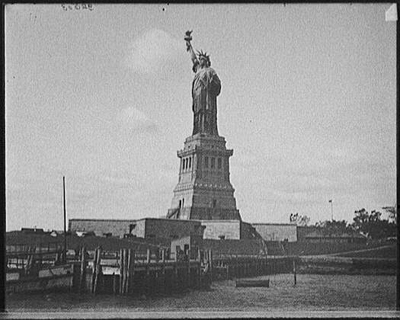
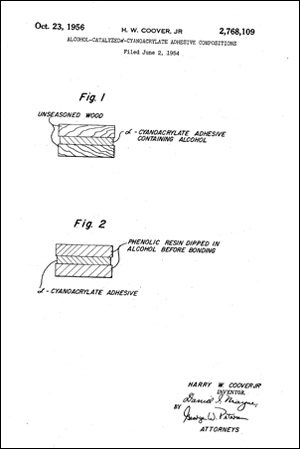 You can add Super Glue to your list of inventions that were discovered by accident. Dr. Harry Coover was not trying to invent a super-sticky substance when he came across Super Glue. In 1945, Dr. Coover was actually working on a way to create a clear plastic to use in precision gunsights for Eastman Kodak.
You can add Super Glue to your list of inventions that were discovered by accident. Dr. Harry Coover was not trying to invent a super-sticky substance when he came across Super Glue. In 1945, Dr. Coover was actually working on a way to create a clear plastic to use in precision gunsights for Eastman Kodak.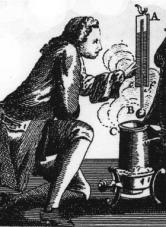 In 1593, when Galileo Galilei invented a basic water thermometer the device was called a thermoscope. His thermoscope and the ones that followed were not standardized in the liquid or the scale for telling the temperature. These simple devices mainly indicated a temperature increase or decrease, but no one was sure by how much. Daniel Gabriel Fahrenheit was a German physicist who changed the way the world viewed temperature.
In 1593, when Galileo Galilei invented a basic water thermometer the device was called a thermoscope. His thermoscope and the ones that followed were not standardized in the liquid or the scale for telling the temperature. These simple devices mainly indicated a temperature increase or decrease, but no one was sure by how much. Daniel Gabriel Fahrenheit was a German physicist who changed the way the world viewed temperature.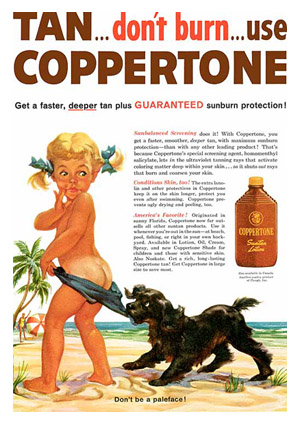 The benefits of sunscreen have been known for thousands of years. Even the Greeks used a mixture of sand and oil to attempt to protect themselves from the sun while training for the Olympics. Christopher Columbus was the first to write about the use of sunscreen. Columbus wrote in his journal while visiting an island in the Caribbean that the people of the island “all paint themselves, some black, some other colors, but mostly red. I have learned that they do this on account of the sun, which does not injure them as much if they are painted.”
The benefits of sunscreen have been known for thousands of years. Even the Greeks used a mixture of sand and oil to attempt to protect themselves from the sun while training for the Olympics. Christopher Columbus was the first to write about the use of sunscreen. Columbus wrote in his journal while visiting an island in the Caribbean that the people of the island “all paint themselves, some black, some other colors, but mostly red. I have learned that they do this on account of the sun, which does not injure them as much if they are painted.”